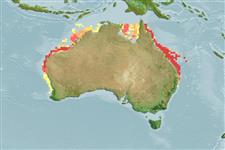>
Scombriformes (Mackerels) >
Scombridae (Mackerels, tunas, bonitos) > Scombrinae
Etymology: Grammatorcynus: Greek, gramma = signal, mark + Greek, rhyngchos = snout.
More on authors: Quoy & Gaimard.
Issue
Date Eschmeyer, pers. comm. Correction to Grammatorcynus is probably unjustified (Ref. 1830).
Environment: milieu / climate zone / depth range / distribution range
Ökologie
seewasser riff-verbunden; ozeanodrom (Ref. 51243); tiefenbereich 15 - 50 m (Ref. 86942). Subtropical; 12°S - 37°S, 110°E - 157°E (Ref. 168)
Western Pacific: known only from the northern coasts of Australia, south to Shark Bay in western Australia, along the east coast of Queensland south to northern New South Wales. Recently reported from the Gulf of Papua (Ref. 9684) and Ouvéa Atoll, Loyalty Islands (Ref. 13236).
Size / Gewicht / Alter
Maturity: Lm ? range ? - ? cm
Max length : 112 cm FL Männchen/unbestimmt; (Ref. 40637); max. veröff. Gewicht: 13.5 kg (Ref. 168)
Rückenflossenstacheln (insgesamt) : 11 - 13; Rückenflossenweichstrahlen (insgesamt) : 10 - 12; Afterflossenstacheln: 0; Afterflossenweichstrahlen: 11 - 13; Wirbelzahl: 31. Mouth relatively small, upper jaw reaching about to middle of eye. Pectoral fins stout. Interpelvic process short and single. No prominent anterior corselet present. Swim bladder present. Vertebrae 14 precaudal plus 17 caudal, total 31 as in the mackerels (Scomber and Rastrelliger).
Form schools near individual bays and reefs in Barrier Reef waters. With the rising tide, they move into shallow water over the reef flats, feeding on schools of clupeoid fishes that concentrate there. Utilized as a food fish.
Life cycle and mating behavior
Maturities | Fortpflanzung | Spawnings | Egg(s) | Fecundities | Larven
Collette, B.B. and C.E. Nauen, 1983. FAO Species Catalogue. Vol. 2. Scombrids of the world. An annotated and illustrated catalogue of tunas, mackerels, bonitos and related species known to date. Rome: FAO. FAO Fish. Synop. 125(2):137 p. (Ref. 168)
IUCN Rote Liste Status (Ref. 130435)
Bedrohung für Menschen
Harmless
Nutzung durch Menschen
Fischereien: kommerziell; Sportfisch: ja
Tools
Zusatzinformationen
Download XML
Internet Quellen
Estimates based on models
Preferred temperature (Ref.
123201): 22.6 - 27.8, mean 26.1 °C (based on 108 cells).
Phylogenetic diversity index (Ref.
82804): PD
50 = 0.7500 [Uniqueness, from 0.5 = low to 2.0 = high].
Bayesian length-weight: a=0.00955 (0.00464 - 0.01966), b=3.05 (2.88 - 3.22), in cm total length, based on LWR estimates for this (Sub)family-body shape (Ref.
93245).
Trophic level (Ref.
69278): 4.5 ±0.80 se; based on food items.
Widerstandsfähigkeit (Ref.
120179): mittel, Verdopplung der Population dauert 1,4 - 4,4 Jahre. (Preliminary K or Fecundity.).
Fishing Vulnerability (Ref.
59153): High to very high vulnerability (75 of 100).
Nutrients (Ref.
124155): Calcium = 13.5 [7.3, 31.5] mg/100g; Iron = 0.667 [0.348, 1.307] mg/100g; Protein = 22.5 [21.0, 23.8] %; Omega3 = 0.207 [0.118, 0.377] g/100g; Selenium = 18.2 [8.9, 38.7] μg/100g; VitaminA = 47.3 [15.5, 157.7] μg/100g; Zinc = 0.447 [0.293, 0.689] mg/100g (wet weight);
